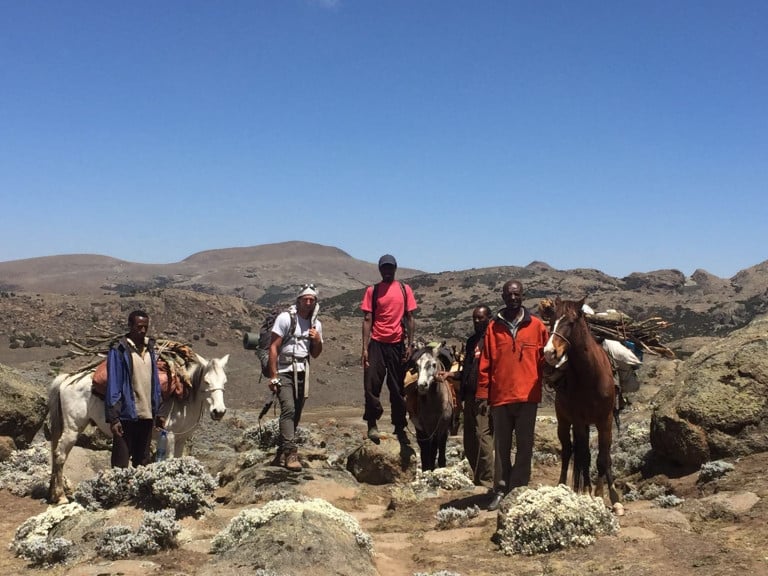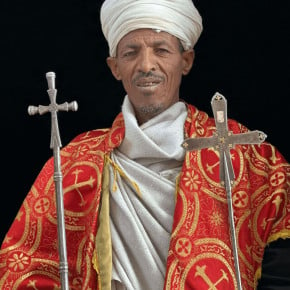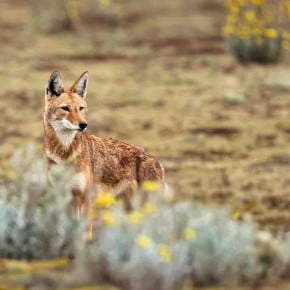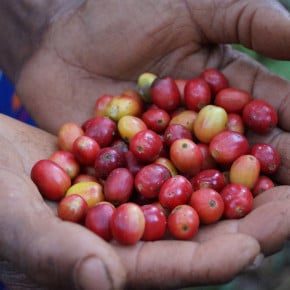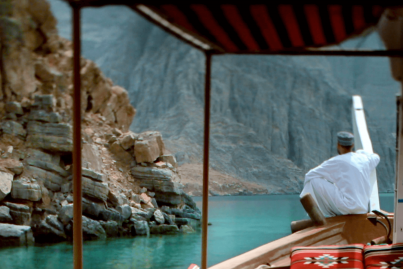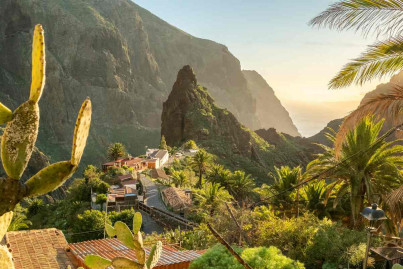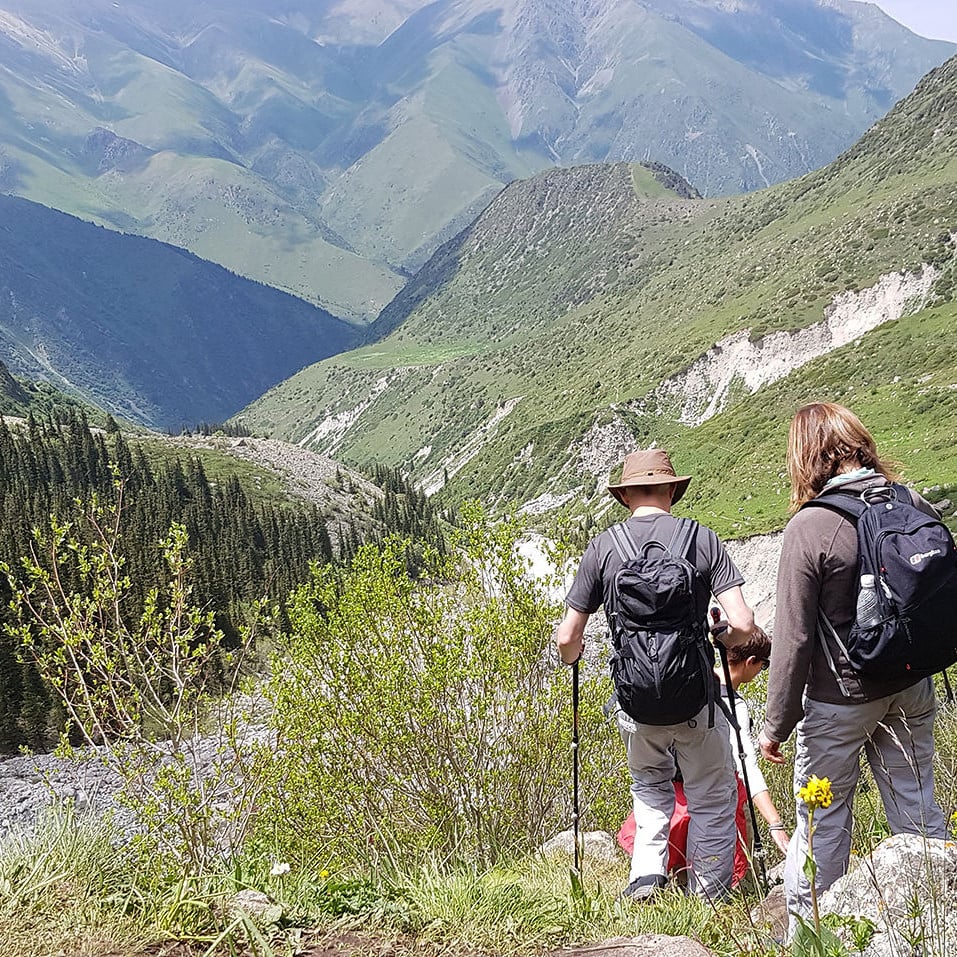Gurbinder Kundi (Binder), a Corporate Treasurer and long-time friend in Dubai, had been hinting for a while that he would be interested to come out and join me for a leg of the trip, and we had subsequently arranged for him to partake in six days out of my ten-day trek across the Sanetti Plateau. Due to the nature of the terrain and the fact that I was now also catering to the needs of someone other than myself, the trip needed some significant preparation – especially when compared with my usual style of ‘turn up with a backpack and see what happens’. With the help of my local contacts I procured a guide, a cook, two horse-handlers with three horses to carry supplies and equipment, ten-days’ worth of provisions, a minivan to pick up Binder from the forest-town of Rira for his journey back to Addis to catch his flight and sufficient funds from the bank in the next town. Having completed all of the permits at the park office we were good to go. The Sanetti Plateau, with an average elevation of over 4000m, is the highest plateau on the continent, and we set out one particularly fine morning to walk across the Rooftop of Africa. Having loaded the horses we headed up into the grasslands just outside of Dinsho.
Setting out across the Rooftop of Africa
Binder carried a daypack but I insisted on carrying my full pack through a combination of habit and stupidity. “It’s good training,” as my dad would say, although what exactly we are training for I have never found out. We were immediately surrounded by an abundance of exotic wildlife. Male and female mountain nyala walked amongst small herds of redback deer. The male nyala, larger than a British stag, have graceful slender curving horns that rise straight up towards the sky with an air of regal nobility. The females are without horns but have the same daintily cupped ears, like the curvature of a leaf designed to catch water, giving them an inquisitive, superior aspect. This, combined with the soft white and grey markings on their fur, make them the most gracious of creatures. These crowds were interspersed with the huffing, grunting movements of large warthogs, their tusks curving out and around from their snub noses. I unsuspectingly came across one at very close quarters in the tall grass and it bolted just in front of me with surprising speed. We crossed the single tarmac road laden with anubis baboons and headed up at a steep incline into the forests of the mountain range on the northern flank of the plateau.
Ancient, lichen-covered monoliths with peeling orange trunks soared above us in a tangle of vines and creepers and then we were up and out onto a sunny pathway traversing the ridge where the vegetation thinned to large expanses of short grass interspersed by masses of ‘everlasting flower’, a deciduous bush that grows in densely packed clumps like silvery rock formations. A collection of three male mountain nyala emerged from a wooded thicket onto an open expanse. As I approached them they bolted, their large limbs throwing up small clods of earth as they comfortably navigated a small ridge, disappearing from sight. Binder and I strolled along in high spirits, led by our guide, Jafer Mohammed, the head of the Bale Guiding Association. I estimated him to be in his fifties but was not so bold as to enquire. A dignified and thoughtful man, I immediately placed my trust in him, which was at no point unwarranted. He may or may not have heard us role-playing particular scenes between the Jafar the evil vizier and his talking parrot Iago from Disney’s Aladdin; “Patience Iago, patience!” and was either too dignified to acknowledge them, or just simply baffled at the idiocy of two men in their thirties.
An African camp and the Ethiopian Wolf
We reached camp in a valley filled with everlasting flower. The horse-handlers had taken a direct route from Dinsho and had already set up our tent while Usman Abdullah, our cook, had fresh coffee brewed awaiting our arrival, next to an aluminum dish of mixed kolo [roasted barley] and peanuts. We lounged about in the sun on our roll-mats snacking on this and boiled halves of potato dipped in salt and Tabasco sauce. This satisfying starter was followed by huge platefuls of penne pasta in a spicy tomato and vegetable sauce, topped off with sweet mugful’s of hot tea. I immediately realized that I had been conducting my trip in entirely the wrong manner, vowing on the spot to never travel in Africa again without an entourage of at least five. My notion was confirmed the next day as I awoke to the sound of Jafer’s voice calling us. “Binder, Sam, breakfast is ready!”. ‘Oh yes’, I internalised, ‘this is how you do it’. Two mugs of buna and two freshly baked chapattis dipped in fresh spicy shiro bean curd later, we shouldered our packs and headed west down into the flatlands encircling the plateau range. The lowlands are the habitat of the endemic and endangered Ethiopian Wolf and we saw several solitary hunters crossing the dusty plain, their glossy red fur catching the sunlight.
After a relatively short walk of four or five hours we reached camp at Sodota to find our tent pitched next to the Ethiopian Wolf research station cabin there. They are truly beautiful animals, foxlike and rather playful-looking in appearance, you forget that you are looking at an accomplished predator. There had unfortunately been a recent epidemic of a disease transmitted from the dogs of the local herders to the wolves, which had tragically wiped out a large percentage of their population in the previous months. I later spoke with the head of the Frankfurt Zoological Society, who are doing as much as they can to save the remaining wolves, and he explained that they had managed to vaccinate a small number of them in time. The herders pasturing their livestock in the park causes other problems including erosion. 12 million people in the surrounding area depend on the water run-off from the plateau, which acts like a giant sponge for rainwater, and the erosion caused by 10,000 or so herders is affecting this supply. It is an on-going issue that requires government attention.
Riding horses in Ethiopia
I was still full of beans after we reached camp and saddled up one of the horses to go for a ride. Our horse-handlers were Abdullah, a large man with huge hands and feet and the countenance of a ‘gentle giant’, and Haji, smaller and compulsively clad in a blue bobble-hat giving him the permanent likeness of an Ethiopian Noddy. Haji explained to me, through Jafer, that horses in Ethiopia are named according to their colouring. Our three stallions where therefore named Odocha – ‘White & Black’, Adi – ‘White’ and Dama – ‘Brown & Red’. In Bale only male horses are used for riding and luggage transport, the females left to raise their young in the fields. You only ever mount from the right-hand-side of the horse in the region, and I accordingly hopped up onto Dama. I stuck to the track as there are many mole-rat holes on the plain, and took Dama through a trot, to a canter then finally into a short gallop. It felt great to be out alone in the midst of such vast empty spaces. I hauled him to a stop and sat for quite a long time staring at the undulating hills in the distance, feeling the soft breeze on my face.
The horses in the park and the surrounding area are large, sturdy beasts and beautiful to ride. I was very pleased to see how well they are treated, with no or extremely limited markings of trauma from over-heavy loads. Abdullah and Haji are both highly competent horsemen, literally having grown up in the saddle, and it was lovely to have Dama, Odocha and Adi roaming free around our campsites, occasionally lying down and having a good roll in any particularly appealing dust baths. Back at the camp one of the station researchers, an Ethiopian, had unlocked the door of the cabin and Binder and I sat inside on cowhide sofas with our feet up chatting about this and that. Outside tiny moreland chats hopped around picking at the dirt daily cleaned out from the mole-rat holes. It is a symbiotic relationship as if the moreland chat is present, the mole-rat knows there is no immediate threat from predators. One fat and rather ambitious little chat hopped in to the cabin entranceway while we were eating dinner at the table, and we fed him some breadcrumbs. He was shortly joined by his friends and some yellow-breasted Abyssinian longclaws.
Viewing the Ethiopian Wolf and the Stone Forest
In the morning Jafer called us excitedly and we ran down to the plain where a family of four wolves were making their way north, often stopping to play amongst themselves, and we were able to get up quite close. We then began our ascent up and around the western side of Sanetti and it felt good to make some altitude. We spooked several wild hares, each bolting with incredible speed, and camped about halfway up by a natural cave created by a huge boulder, where Usman built a fire for cooking. The boulder was beneath a large ridgeline running for about 300m some height above us. The line was comprised of rock formations averaging about six meters high, resembling the stone statues of Easter Island. It was like camping below an army of sentinels. Binder and I climbed up and onto the highest sentinel to watch the saffron orb of the sun gently dip through the valley we had walked up that day. Usman, Abdullah and Haji rolled out a rug facing Mecca to the northeast, and in a neat line bowed down and prayed. That night the temperature plummeted at around midnight and we were both glad we had brought good sleeping bags.
The next morning we were right up in the grasslands of the plateau, everlasting flower giving a silver sheen with hints of azure to the rolling hills. We could feel the air thin and were afforded an amazing view across the entire western plateau to the mountain formations in the distance, broken in layered contours like ploughed earth. The sentinels of our camp had only been a foretaste of what was to come as our path led us past a huge gorge crowned on all sides by what Jafer called ‘the stone forest’. It stretches for miles and truly resembles an alpine forest, the only difference being that it is made entirely of free-standing smooth rock formations that twist up in bizzare, unpredictable shapes. Walking in and around them, we headed in a southwesterly direction until we were delighted to find that our camp at Rafu was set amongst the formations, our tents pitched in the middle of small rock circles. A woman with two young children was staying in a very large grass-thatched hut nestled amongst the stone trunks. Binder, Jafer, Usman, Haji, Abdullah and myself sat around a fire in a smaller grass hut next to a dung-fenced goat corral. The woman gave us fresh cows milk as a gift of hospitality and we drank it with our coffee.
A view of Africa’s highest plateau
Binder and I decided to walk up a nearby hill to see the view. The long expanse of the steppe revealed itself with shadows cast down from the atmosphere gliding across the pale flaxen tableland. Facing south, the plateau plummeted down in front of us for a thousand meters in heather-clad mountainsides leading to golden barley fields, groves of giant bamboo and the lichen-covered Harenna Forest, wild arabica coffee growing in the far south where lions and wild dogs can still be found. To the west layers of peaks and ridges backed up in ever watered-down rows of colour until they became indiscernible from a fat sky, pregnant with cumulonimbus clouds resting in billowing heaps. On our way down Binder played some music from his phone and just as the sun threw out its last shards between the giant lobelia and the mind-bending stone forest in front of us, Led Zeppelin’s Stairway to Heaven came on the playlist. No more perfect song could have better fit the scenery. In the morning, light flooded through the opened tent flap, framing a view of Dama grazing. We entered the jungle town of Rira through countryside dotted with houses constructed entirely from bamboo fronds, the weaving tapering up to form flimsy points; the locals effectively living in giant baskets.
We sat by the roadside and ordered sodas as being a Muslim village they sold no beer. We continued on past a mosque constructed entirely from corrugated tin sheets, and another twenty minutes down the road we had reached our campsite, which was a relief as it was very hot now that we were down from the highlands. We were aware that we were rather dirty and so headed down to a nearby stream for a good wash. Finding a lovely little number trickling through a pasture, we followed it up to where a small waterfall afforded a natural shower beneath a large tree covered in spider webs. We stripped to our underpants and took turns scrubbing ourselves with soap and splashing in the refreshing water. Back at the campsite we sat on the soft grass in the evening sunlight, chatting the night away with our companions and a local scout manning the area for the government. Jafer told us that Binder was the first person of Indian heritage “– Hind!” that he had ever seen walking in the mountains. In the morning the three of us ventured into the bamboo forest and sat beside large shady rock pools, watching ten-meter high waterfalls gush into them.
Partings from the group by the Harenna Forest
On the way back to camp we crossed the river that leads to the waterfalls and found Usman and Abdullah washing their clothes upstream from two young girls, involved in the same occupation. The girls were cooking some form of inedible sour apple in a vat over a log fire as when cooked the apples make an effective soap. The girls used their feet to work the lather into the family blankets amidst much giggling and snatching of glances at the two foreigners. I had had the unprecedented foresight the previous day to call Ahmed, Binder’s driver, and ask him to bring us eight cold bottles of beer. When we reached camp we saw that the minivan had already arrived and we sat on the grass drinking the cold suds watching three horses being driven round in a threshing circle in the barley field next door. It was Valentines Day and it seemed not a dreadful way to spend it. Binder and I said our goodbyes after lunch, “– see you Cracker,” “– see you Coco,” and I figured that now was as good a time as any to try some khat. Usman brought a load from the village and the six of us, including the scout, sat in a circle on the grass. Abdullah briefly left to the stream to fetch some water and upon his return said that he had received a call from home informing him that his wife was having a miscarriage at five months pregnancy.
He left immediately to the village to catch a bus. I saw him later in Dinsho and although his wife had indeed lost the child, she was not herself greatly physically harmed, which is no small blessing in a remote area. I had made sure he was fully paid for the time he missed due to this tragic occurrence. Although all feeling bad for Abdullah, there was nothing we could do to further help him so we returned to our circle and palaver. One simply chews and swallows the khat leaves amid sips of water to clear your mouth out. Although not extremely potent in its effects, I gradually felt a compelling feeling of elation combined with a strong clarity of thought, and enjoyed speaking with Jafer at length on a number of topics. We had dinner, after which I had a small stomachache, and I awoke late in the night and was unable to get back to sleep, which is apparently one of the common side effects. Emerging from my tent in the night, the stars of the Milky Way sprawled across the sky in a glittering mass, a half moon illuminating the pale fields.
Heading back to the Highlands
In the morning Jafer and I set off up the road to climb back into the highlands. Haji and Usman followed shortly after as soon as the horses were loaded, our party of six now reduced to four. Following the winding track up we passed a group of Columbus monkeys jumping between several large trees. The black and white markings of their faces give the impression that they are wearing a Cardinal’s hat; one male sat watching us in religious repose on a high branch, his long slender tail with its bushy white end hanging down. We stopped for a short break in the shade between some giant heather trees and a young man with an Islamic-style beard, shaved at the front but left to grow thick around the chops and chin, walked down the track towards us from the other direction. He knew Jafer and the two men chatted in Oromo while I, for lack of anything better to do, sharpened his plastic-handled machete with a sharpening stone I kept in my pack. Just as we neared the top of the climb the horses caught us up and we all sat together eating chocolate spread lathered over chapattis in the sunshine, playing on our phones.
Climbing to the top of Mount Tuludimtu
Our supplies having dwindled, only two of the horses now carried the luggage and Usman and Haji took turns in riding Odocha. In direct contrast to the natural abundance of the valley we had just come from, back on the plateau there was an eerie silence, broken only by the whistling of the wind. We made for the lee of a towering mountain of rock, a couple of grass huts huddled around its base, and camp was struck as soon as Haji confirmed there was good water in a nearby stream. We were at the foot of Tuludimtu, the highest peak of the plateau and the second highest of the country. It was supposed to be another three days back to Dinsho from this camp but I ruined everyone’s plan by heading up to the top alone as it was only mid afternoon and it was just right there. Hopping over the stream I picked my way through the boulder-strewn landscape on a faint path that led up in a long arcing curve to the summit, Towards the top I could really feel the thin air and was breathing very heavily.
There is a small telephone station perched on the pinnacle with numerous cream-coloured satellites fixed to the steel mesh of a tower. I could tell that Jafer had felt guilty in my going alone and he had said that he would phone to check on me. At the top I realized that my phone battery was just about to die and knew that he would worry and probably even come after me if he couldn’t contact me, so I laid my folding solar panels on a rock with the cord plugged into my phone. The satellite station is always posted with a guard on a five-day rotation and the current poor soul on duty came over to greet me. He had on a large ALASKA beanie hat with a scarf hung over his head beneath it and down each side looking like long ears. He had no front teeth and somehow resembled a friendly teddy bear. I also had my hand-held steady-cam-mounted video camera with me, which does not look unlike a laser gun, and had a strange little Star Wars moment to myself, reasoning that I must just be tripping on the altitude somewhat. Saying that, the view around me was from another planet; beneath a cobalt sky, light flaxen shades touched with olive, azure and rust spread out all around me, shadows from fast-moving clouds drifting across them at pace.
The journey back across the windswept plateau
It was barren and beautiful and I felt a pronounced sense of calm. Jafer called and I let him know that I was fine and would head down in an hour or so. My teddy bear friend turned on his box radio which proceeded to blare out national songs, most of which I knew and was now thoroughly fed-up of, so I moved away from him and walked around the satellite station looking at the views on all sides. It felt like the end of my journey. I would never be able to top this. I also missed having my friend around to share it with. I spent what may have been an hour lost in thought, more feeling the place than observing it, basking in the far-reaching perspectives that mountains afford to life. I said a final farewell to the vastness and headed back to camp, each step now a return compared with the odyssey that had preceded them. In the morning, as Jafer and I skirted the southern base of Tuludimtu heading east, a sea of cloud nestled right up to the table’s edge in plumes of fluffy cotton wool bedding, the valley of Rira now completely obliterated by the wispy mass. Regardless of a strong wind whipping at our faces, the skin drying out under the sun’s undiluted force, I just had to see the cloud line from a little higher up and asked Jafer to wait in the shade of a large boulder while I clambered halfway back up the mountainside to take in the whole view.
After dropping down a little from a long walk over the cloudland, we passed our initially planned campsite of Gebre Garacha [Black Water], a huge windswept lake of Atlantic blue and had our lunch there instead. We then continued our route march northward with a lot of ground to cover and Jafer setting a fine pace. We stormed across a wide alpine valley of grass and everlasting flower, small peaks on either side and straight ahead, culminating in the perfect pyramid of Wassama Mountain. It felt like a cross between Switzerland and the Lake District, only lifted up on stilts, floating on cloud, in Africa. We reached camp after about three and a half hours with no break. We had both kept a good pace and enjoyed the march but upon arriving the adrenaline stopped and both of us felt tired. Jafer curled up in a thick gabi next to a fire that Usman had built in a natural cave (he and Haji had taken a shortcut with the horses skipping the lake) and I dozed in my tent for twenty minutes. A young girl from a family of herders staying up above us brought us cows milk and Jafer and Haji joked with her as she had never seen a foreigner before. We gave her a hot chapatti covered in jam but I don’t think she liked it much.
Pastoral scenes on the route back to Dinsho
The stars shone brightly as we all sat around the fire in the lee of the cave, smoke occasionally drifting into our eyes. On the long decent to Dinsho the following day I realized that we had gained the plateau via something of a side stairwell, as the northern approach was open and large and you could see everything. As the mountains of Sanetti receded behind us in a crown of tussling watercolour peaks, lesser mountains and scenes of pastoral bliss presented themselves. We walked through many settlements with much harvesting of barley and horse threshing. One farmer holding a small curved sickle knew Jafer and joked for him to come and help. Trees appeared again and children played around streams trickling through soft pastures. We were back in the world. I had met an Italian gentleman called Luigi in the Gheralta Mountains who has lived for many years in Ethiopia. He stood me an excellent lunch and afterwards when we were talking he had said: “You know, if you really want to see this country you have to get off the roads. You have to walk through it on your own two feet. Your own two feet.” He wasn’t lying.
The end of the adventure
After a brief sojourn in the Sothern Nations eating fried fish and watching hippos at lake Awasa I headed back to Addis. My trip was over and I knew it. Whereas before I had found the capital claustrophobic and dirty, now I reveled in its diversity, craving again the luxuries of modern civilization. I went to dinner at the best Italian in town [Castellis – we knew it was the best place in town because there was a framed photo of the proprietor and his wife gawping next to Angelina Jolie and Brad Pitt] with an American friend of mine and we had spaghetti in a truffle sauce and linguini with saffron and drank good red wine. I went to watch a band comprised from all of the African nations along the Nile play in a theatre on instruments I didn’t understand. I sat in the garden of the oldest hotel in the country drinking macchiatos, writing in the shade of a tree. I went to house parties. I went on a date with a local woman to a wine bar and we talked for five hours. Some friends from London were hosting a conference that week at The Sheraton and we stayed up late listening to live jazz with the bar tab covered. I took taxis when I knew I could have taken the metro, I had spaghetti with cream and spinach for breakfast with a beer as well.
But it soon began to wear off, and in the quieter days as I cast my mind back over my journey, I realized that the country had, without me realizing it, reignited a small flame within my breast that I had carelessly allowed to become smothered, starved of oxygen, and finally extinguished altogether. Here it had continued to burn with an ever-increasing strength, as the days and miles past, until once again it was a roaring flame. For I felt alive. I felt life flooding down through my very arteries. And you can’t ask for more than that now can you.
